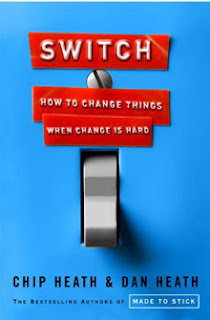| Dilbert comic strip for 9/13/2010 from the official Dilbert comic strip archive |
Many companies have a difficult time changing how they are
used to doing things in order to move towards the digital age. Many might as
well be in the Stone Age when it comes to understanding how digital analytics
and other tools such as social media can be used to help their organization and
how they should be implemented. Without this understanding, they fear changing
what they have grown accustomed to doing in order to move towards this new
frontier. This resistance in a
corporate organization can seem daunting to younger professionals trying to
persuade and help these limping organizations take that leap. (Dykes, 2010)
Here are five broad level steps to help you begin developing
a plan to move change within your organization along:
Step 1: Look at what is working right now
Many times in an organization, a change leader looks at what
the problems are in an organization and moves to fix them. This harbors more
resistance from an organization as most people resist being fixed. In order to
garner trust from the organization and its individual members, it is better to
first look at what is being done right, what is working and highlighting those “bright
spots” as Brent Dykes puts it. (Dykes, 2010)
Step 2: Where do you want to be?
Everyone needs to know where they are going. If we don’t
define where we want to be, you’ll only be left wandering blind. Clear direction
must be given so that you can effectively measure between where you are now and
where you want to be. Having a “vivid picture from the near-term future that
shows what could be possible” helps you appeal to the rest of the members of
your organization and ensures you are all able to move down the same path
towards the same destination. (Dykes, 2010) (Heath &
Heath)
Step 3: Lay out specific details or actions to take
Chip and Dan Heath from the book “Switch” use the example of
an elephant to describe how best to handle change in an organization. “The
elephant will always want to stick to the familiar path (status quo). Your
organization will need more than just a vision for becoming more data-driven
but also specific details or actions.” [2] This is a critical key. Now that you’ve
determined where you are and where you are going, you must create goals to
achieve, planning them out with those specific details and actions to ensure
everyone is on the same page. Without SMART
goals, and ways to achieve them set, an organization will keep on the same path
it has always been on. (Heath & Heath) (Arina, 2010)
What kinds of goals are good goals in the realm of analytics
you might ask? Avanash Kaushik, a Digital Marketing Evangelist, suggests you
link your goals to the business. Find metrics that show how the digital frontier
affects the bottom line. Stay away from clickstream, he suggests. It becomes “old”
quickly. Figure out what motivates your audience, what brings them to your
site. Make sure these goals or metrics are SMART, and be willing to change them
as time goes on. (Kaushik, 2006)
Step 4: Deliver Hope wrapped in small wins
When everyone feels involved, change in an organization is
much easier. Giving people a purpose and making them feel important and
involved will make them more willing to change for you. Make everyone an
analyst. Ask them for their opinion. What do they see in the data? Just because
you have reports, doesn't mean you know what’s happening. When you find
successes, make sure everyone knows. Deliver these to the organization so they
can see the worth. (Dykes, 2010)
Step 5: Encourage Good Habits through developing a culture around Analytics
Corporate culture can be elusive, yet when developed right,
it can enhance and impact an organizations work environment and output.
Developing a culture around analytics is not simple, but can be done by
developing rituals and routines such as announcements about the company’s
digital successes in a given time period. (The Cultural Web)
To learn more about organizational change whether it be
about analytics or not, I recommend reading “Switch” by the Heath brothers, as
well as taking a look at Johnson and Scholes’ Cultural Web. For more on
Analytics, I recommend Avinash Kaushik’s
Blog. Best of luck to you!
Works Cited
Arina. (2010, February 20). SMART Goal Setting: A
Surefire Way to Achieve Your Goals. Retrieved January 20, 2013, from Goal
Setting Guide:
http://www.goal-setting-guide.com/goal-setting-tutorials/smart-goal-setting
Dykes, B. (2010, July 29). Switching to a
Data-Driven Culture. Retrieved January 20, 2013, from Adobe Digital
Marketing Blog:
http://blogs.adobe.com/digitalmarketing/analytics/switching-to-a-data-driven-culture/
Heath, C., & Heath, D. (n.d.). Switch.
Retrieved January 22, 2013, from Heath Brothers:
http://www.heathbrothers.com/switch/
Kaushik, A. (2006, October 23). Seven Steps to
Creating a Data Driven Decision Making Culture. Retrieved January 22,
2013, from Occam's Razor:
http://www.kaushik.net/avinash/seven-steps-to-creating-a-data-driven-decision-making-culture/
The Cultural Web. (n.d.). Retrieved January 22, 2013, from Mind Tools:
http://www.mindtools.com/pages/article/newSTR_90.htm


These are some very good points. The lack of qualified analysts also contributes to slow organizational change. Decision makers will delay the change for as long as they can, unless someone (analyst) can show them that changing sooner will benefit more.
ReplyDelete